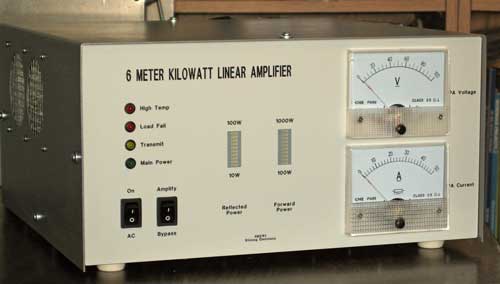Comments? email to
![]()

You only need a bit over 1w in for a KW out on this one; the amplifier shown here has an internal 16db attenuator so it can be used with drivers in the 50 to 100w range.
However, if you have one of the QRP 5w or 10w radios, this
attenuator can be bypassed via rear-panel jumpers.
 A couple of years ago, F5FLN described a 6 meter KW amplifier
he built modeled after the Freescale MRFE6VP61K25H reference design for an
88-108MHz FM amplifier. It was published in Dubus magazine, and looked like a
worthwhile project. At the time the article was published, I was busy with other things and
decided to put it aside for a while.
A couple of years ago, F5FLN described a 6 meter KW amplifier
he built modeled after the Freescale MRFE6VP61K25H reference design for an
88-108MHz FM amplifier. It was published in Dubus magazine, and looked like a
worthwhile project. At the time the article was published, I was busy with other things and
decided to put it aside for a while.
Recently I got back to it, and though I liked the F5FLN design, I thought it might be a bit easier if I just scaled the 2m amplifier I was already using; this allowed me to use the same PCB, copper spreaders, etc. I was already using for 2 and 222. It turns out the F5FLN output design was a bit better than my first attempt with scaling, so in the end I wound up using parts of both designs before I was done.
The result is the RF deck shown here. The transformers are much longer than they were on 2m, so it was necessary to form them up a bit to keep things compact; a ferrite core was required on the input transformer, and a bit of input matching help via a coil/capacitor ahead of that transformer. Oddly enough, this design required no matching capacitors on the output side; the transformers do all the work. VDD feeds are small toroid chokes, and I doubled the number of DC blocking high current MC18 mica caps. The result was an amplifier that performs great. As with the other designs using this LDMOS part, you do need to use a low pass filter on the output to take care of harmonics.
If you are building this RF deck from a kit I supplied, the assembly instructions are here:
If your kit was shipped after July 2016, your RF deck
assembly instructions are here:

One of the advantages of using the same footprint for the RF
deck was being able to fit it into the standard enclosure I was using for the
rest of the VHF KW amplifiers (see the articles on the 2m and 222MHz versions).

Since the other articles (2m and 222) detail the construction pretty well, I'll just mention a small difference on this one, and that is the 60cm of RG142 you can see coiled up in the forward part of this photo. For this particular device (Freescale 1k25H), 60cm was the correct length; for the BLF188XR, 30cm was about right.
This is a "stand-off" transmission line connected between the output of the RF deck and the input of the low pass filter assembly.
Because the third harmonic level is high, some danger to the LDMOS exists if this energy is not reflected back from the filter in the correct phase. Some experimentation with the length may be necessary, but a general rule of thumb is to use a length that will produce a minimum of 60% efficiency. If the length of this stand-off coax is incorrect, you will know...the efficiency will be low (less than 60%).
The arrangement is quite effective; the output is very clean,
with all harmonics down at least 60dbc.
Performance data and
RF deck schematics are shown below. The drive power readings are not accurate at the low
end, the power meter I was using barely registered there. After about 1/2w, I
was able to read more accurately.
Even though the output levels do look wonderful, keep in mind these preliminary charts show unfiltered output from the rf deck; the third harmonic level at this point is only about 10db down, and accounts for around 100w of the full output shown; once it is removed with the filter installed above, output levels and efficiency are more in line with what one can expect from these devices.

The next chart shows test results using an NXP BLF188XR device, and the readings on this one are more accurate:

The schematic shown below is the latest revision (it differs slightly from
the original prototype)

